Stanisława Błażków Kennedy
Stasia Kennedy is a typical New Zealander—staunch and understated. Those who know her
maiden name, Błażków, will recognise her typical Polish traits of stubbornness and courage.
Pani Stasia may be slowing down—slightly—in her eighties. Her Wainuomata home sparkles, in complete contrast to
the squalour she left behind in the USSR in 1942 when she and her father were among the last evacuated by the Polish army to
Persia.
By then her mother and two sisters had died of typhus in the USSR, and she knew malnutrition claimed her father soon after
they escaped. When she arrived in New Zealand in November 1944 she had not heard from her brothers who, she hoped, had both
joined the Polish army.
Finding Pani Stasia through her brother Władysław in September 2014 was serendipitous, and I am grateful to her for
agreeing to tell her story to a stranger, for her generosity, her hospitality, and her continued ability to make me
smile.
My best wishes and admiration for a feisty Pole.
—Barbara Scrivens
“I WILL LOOK FOR YOU”
by Barbara Scrivens
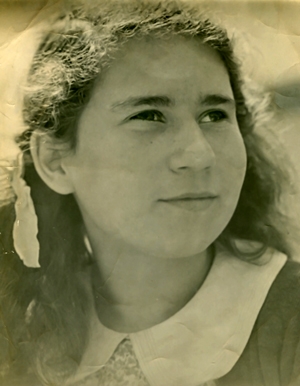
An outstretched hand needs no translation, eight-year-old Stanisława Błażków told herself as she walked up and down a road in a remote part of southern USSR in 1942.
Stanisława, known as Stasia, did not walk far. She made sure she could still see the ramshackle hut where her gravely ill father, Michał, lay. She knew he could not help her. The narrow road, and her fear of losing sight of the hut, limited her begging area.
As much as she tried, her outstretched hand did not work.
Her clothing ragged, Stasia was acutely aware of how out of place she looked among the local people where “dark women wore long habits, carried things on their heads and babies on their backs.” In the previous few months she had become a focused child, with food, shelter and the welfare of her father uppermost in her mind. She had no idea where she was but—judging from the women she saw—she believed it was India.
She and Michał had wandered alone for so long, they could have been anywhere. The unoccupied hut seemed heaven-sent. They found it next to a creek a little way apart from other houses.
“We had nothing, no blanket or pillow… no cup or spoon or anything like that and I couldn’t bring [the water] to him so he crawled…”
“There were no windows, no doors, nothing inside. It was just a little square with four steps. There were wooden boards on the floor. I don’t know why they would build something like that. My dad was six feet and the hut was so small, he had to sleep with his feet hanging out of the doorway. He was still walking when we found it but after that, he couldn’t stand up.”
Without food, Stasia remembers her struggle to get her father to at least drink from the creek.
“We had nothing, no blanket or pillow. We slept on the floor. I had no shoes, only one dress and a pair of knickers, no cup or spoon or anything like that and I couldn’t bring [the water] to him so he crawled there and crawled back again. I tried to help him but…”
Leaving her father and venturing into the community was Stasia's only option for survival.
“I could see I was the only white girl walking among these dark people. I walked up and down that street for a few days and no one gave me anything. No one attacked me, but no one gave me any food. I walked as far as I could and still be able to see the hut where my father was.
“Then one day a lady came up to me, a white lady, and started speaking to me in Polish. She said somebody had told her about the little white girl walking in the street and she asked me my name and why I was there. I can’t remember her name but she said she ran a nursery school during the day and was married to a rich local. She gave me some food and told me that the next day I should carry on walking straight along the same road until I got to the big building, knock on the door and someone would open it for me.”
That meeting saved Stasia’s life and extended her father’s. She did as the woman instructed the next day—and the days that followed—walking out of sight of the hut to the building and chatting briefly to the woman who gave her more food and more instruction.
“She said, ‘Stasia, don’t drink water from the creek because it’s polluted.’
“I said, ‘We have to drink,’ so she said to me, ‘I will show you how to boil the water,’ and she gave me a little tin with a handle and showed me how to light the matches and boil the water before we drank it.”
“I’m going to make sure you get on that boat because if you stay here you’ll die and your father will die.”
Stasia knew the creek—about a metre wide—did not have clean water: She used to wash herself and her clothes in it. Without soap, she would dip her dress into the water, rub and shake it a few times before laying it on a bush to dry.
She does not know how long they stayed in the hut but remembers the day the woman told her that she had heard of Polish refugees leaving by boat and promised Stasia, “I’m going to make sure you get on that boat because if you stay here you’ll die and your father will die.”
The news of other Polish people nearby was a surprise to Stasia. She had thought they were the only Poles in the area.
_______________
Three years earlier the Błażków family lived quietly on their farm in Berezki, in the Czarnokońce Wielkie region, a few kilometres from Poland’s eastern border with Russia.
Stasia was the youngest of five children. Her elder brother, Władysław (Władek), was born in 1921. (See Pan Władysław’s story on the polish veterans page.) Between them were Bronisław (Bronek), Czesia and Kazia. Michał and Barbara Błażków bought into the new kolonia (settlement) after selling other farms farther south.
“There was a paddock and a river and if you crossed the river you were in Russia.”
Apart from her extreme fear of the Soviet soldiers who barged into their home, Stasia has little recollection of the dark early hours of 10 February 1940 that marked the end of their life in Poland.
“… a lot of people died… At every stop they would check and throw them out into the snow.”
“It was winter in Poland and [the soldiers] came banging on the door and said, ‘You’re going to Siberia.’ So we went on the train they used to transport animals and we were sitting on the train… for the toilet we only had a hole in the floor and had only one burning wood stove and I remember that a lot of people died… At every stop they would check and throw them out into the snow. You couldn’t leave the train, but we got to Siberia. The whole family got to Siberia.”
The Błażków family were among an estimated 900,000 Poles forcibly removed from their homes in similar ways and part of the estimated 1,700,000 Poles who disappeared into the USSR after the Russian invasion of Poland in September 1939. The Soviet NKVD (Stalin’s secret police and the forerunner to the KGB, officially the USSR’s Ministry for the Interior) systematically organised the removal of anyone considered “anti-Soviet.” The entire Polish population fell into that category.
First to disappear into USSR were those Polish soldiers captured during the Polish army’s lone defence against dual attacks from the German and Russian armies between 1 September and 9 October 1939. In Russian-occupied eastern Poland policemen, magistrates, community officials, mayors, large landowners and businessmen joined the prisoners of war.
The NKVD murdered more than 21,000 Polish officers and buried them in the forest near Katyń and other locations near NKVD prisons in western Russia. Non-commissioned ranks and some officers, and civilian men arrested early in the Russian occupation, went to prisons, gulags and mines deep within the USSR.1
Stalin had a reason for keeping non-combatant Polish citizens alive a while longer: They were to populate the thousands of forced-labour facilities set up as part of his rolling Five-Year plans to transform the Soviet Union into an industrial power.
The NKVD organised four sets of forced removals of Polish citizens. The Błażków family fell into the first wave of of primarily former soldiers, who had fought in the 1919-1921 Polish-Soviet War, and their families.2 The operation included younger families who had nothing to do with that war but who had taken up farming in eastern Poland.
Stalin stopped emptying Poland of its citizenry only when the Germans started pushing the Russians from eastern Poland on 22 June 1941.
The first three groups—each of more than 200,000—in February, April and June 1940, went to forced-labour facilities to cut timber for the expanding Soviet railway network. The last set of civilian evictions in June 1941 included family members of those who disappeared before February 1940, and few travelled past Kazakhstan.
Stalin stopped emptying Poland of its citizenry only when the Germans started pushing the Russians from eastern Poland on 22 June 1941. When Hitler turned enemy, Stalin found another use for the Poles already on his soil and arranged with Polish Prime Minister General Władysław Sikorski to ‘amnesty’ them so they would form a Polish army on Russian soil and bolster the Red Army frontline.
_______________
Stasia recalls their accommodation in the NKVD forced-labour facility as a room with a dirt floor, and being grateful that their mother had packed duvets and bags of flour. Stasia’s sense of responsibility emerged after the flour ran out. She tried to augment the meagre rations earned by her parents and Władysław in the forest:
“I used to go and stand in the queue to see if I could get some bread but by the time I got there, the lady said, ‘It’s gone.’”
Whether the woman was telling the truth or not, or whether Stasia did not realise she needed to present more than herself to receive rations, she never got the loaf she hoped to present to her family—but one day the woman did give her a slice of bread.
“I ate it before I got home so instead of going home straight away, I went into the street and begged but people wouldn’t give me food…”
Stasia, aged six, was surprised other people would not help her. She did not comprehend that others were caught in the same dire circumstances. She was more successful at foraging once winter was over, taking her haul of berries or mushrooms to her mother to check whether they were edible.
Stasia remembers a woman coming to her hospital bed, telling her coldly that her mother and sisters were dead, and that she and her brothers had to leave.
Some months after the Polish-Soviet Agreement was signed on 30 July 1941, six members of the Błażków family walked out of the NKVD facility—weakened by hunger and illness, but intent on looking for the Polish army’s enlistment stations in southern Russia. On the way they met Bronisław who as a 13-year-old had been sent to jail for ‘stealing’ a pencil. For a brief time in Uzbekistan the family was intact. All of them—apart from Michał—were hospitalised with typhus and taken to a Russian hospital. Stasia remembers a woman coming to her hospital bed, telling her coldly that her mother and sisters were dead, and that she and her brothers had to leave.
Władysław and Bronisław joined the Polish army separately but not even the most liberal Polish enlistment camp could accept Michał, 62 years and in failing health. He and Stasia attached themselves to a group of Polish civilian refugees and “started travelling.”
“We had no food and we couldn’t speak the language but every night they used to kill dogs and we used eat that. I didn’t know it at the time but I was hungry so I ate what I was given.” Stasia recalls the mutual agreement of the group to move on when the locals started looking for their dogs.
She does not remember exactly how she and her father became separated from their group. It was definitely not because the two of them got off a train to look for food. That had happened to Władysław, and Michał must have known he did not have the same strength to run after a train. Stasia, too, feared getting off. She had seen too many people left behind. Ultimately, they were forced off when their train collided with another one.
“It was just a light smash. Some people were hurt and some died but we didn’t get hurt. It wasn’t in the desert but there were no houses. Someone came and took us away but I can’t remember properly.”
All she knows is that suddenly they were alone.
_______________
Father and daughter started walking. Conversation then—as in all their time together—did not stretch beyond basic necessities but Stasia did not need to be told the obvious: They had to keep moving.
… she did not fear dying as much as that when they did, no-one would find them.
Stasia remembers her father as tall with white hair, and her mother as small with straight, black hair and a fringe. During their time in the little hut, she did not fear dying as much as that when they did, no-one would find them—a feeling that only dissipated once the woman in the large house told her about the possibility of being able to leave. That they were able to do so relatively quickly suggests they were near Krasnovodsk (now Turkmenbashi), a port city in what was then Turkmen SSR (now Turkmenistan). The Polish army arranged two evacuations of soldiers and civilians in April and August 1942 from Krasnovodsk to Pahlevi in Persia (now Iran) before Stalin closed the borders to other Poles still trying to escape.
Stasia does not remember getting to the shipping vessel. The woman from the large house “came for me and helped my father onto the boat. She gave me some sandwiches or something like cakes. I didn’t eat it. I kept it for my father. We got on the boat but there were so many people, we nearly kissed our knees, we were so squashed. We had no seats. We sat on the deck. Every couple of minutes they were throwing a body overboard.”
The presence of so many soldiers in the image below indicates this was one of the early transports.3
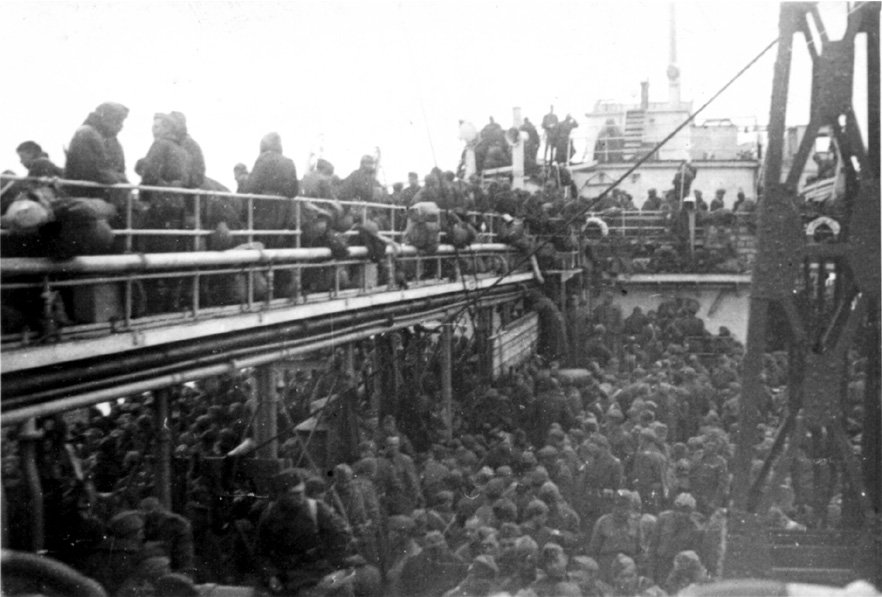
“The food that lady gave me was wrapped in a cloth, I was keeping it so long it was stale. I can’t remember what it was… I went to look for some water so I could soak it and my dad could eat it. No one took any notice of me and pushed me to the side. I saw a man with a cup and I thought it was water so I grabbed it out of his hand and he hit me but I took off and soaked that stale food… My father swallowed it but he was that sick, I knew he couldn’t get off the boat on his own.
“Where we landed, there was a lot of sand, and tents with no sides, and a lady came up to me and said to me, ‘Are you on your own?’ I said, ‘No, my dad is very sick and can’t move.’
“They came with the stretcher and put my father under that shelter on the top of the sand. A lady came over and asked me my name and then said, ‘Stasia, we’re going to take your dad away to get better.’
“My father said, ‘Stasia, when I get better, I will look for you.’ I never heard from him, or from those ladies, again. No one told me anything.”
Although it meant parting with the last member of her family, Stasia was in some way relieved to relinquish responsibility for her father, and be looked after by others.
Stasia was taken away to an orphanage. She knows her father must have died. The last verification of his existence is a record of the two of them arriving in Teheran as a “family unit” in 1942, in the Lista Ewakuowanych z ZSRR Rodzin Polskich w Ciągu Sierpnia 1942 (List of Polish Families Evacuated from the USSR during August 1942). It is held at The Polish Institute and Sikorski Museum in London.4
Although it meant parting with the last member of her family, Stasia was in some way relieved to relinquish responsibility for her father, and be looked after by others.
“The lady took me to the orphanage and the kids welcomed me… accepted me with no trouble. It was good to have someone the same age to talk to. The lady who looked after us was nice, never cruel to us. If there was something like an apple to eat, she cut it in little pieces so everybody got a piece. The walls were eight feet high and in the middle we had a table and seats and if the weather was nice, we didn’t have school, we just had to run around, jump around, do gymnastics. If it was windy and cold, we used to do a little bit of homework, learning Polish, but if it was a fine day, we didn’t do any school at all. I remember sleeping upstairs. There were no windows, only little squares about 12 by 12 inches with netting over.
“I remember they gave me raw eggs to drink and we had a dish, like an army dish, and a spoon and fork and knife and you had to keep it in your bag. When we finished eating, we would wash up and take it back.
“We had no hot water. We only had a well and once a week we used to go to have a Roman bath. They gave us two dresses. One to wash, one to change into and I remember I had shoes and, when we came to New Zealand, I still had those two dresses in a little bag.”
Stasia later discovered that the Persian king, who visited the orphanage and for whom the children gave a concert, was apparently one of the richest men in the world.
“Why didn’t he help so many of his people lying on the street, crying with pain and hunger?” Solid gates with three catches kept the local population removed from the children inside.
One day they noticed a girl of about two or three abandoned at the gate.
“The ladies in the orphanage said they couldn’t leave her there. They took her inside. She had dark hair and olive skin and kept saying, ‘Matula, matula.’ Those were her only words, so they named her Zosia Matula.”
_______________
After two years in Persia the children were told of their next destination—New Zealand. Stasia, like many others, had never heard of it.
“They aren’t going to eat me because I got no meat, only skin and bones.”
She remembers somebody whispering, “It’s the end of the world. They’ve got black people eating white people.” The logic of the youngest children allayed any fears about becoming part of a meal: They answered, “They aren’t going to eat me because I got no meat, only skin and bones.”
Stasia was one of the 733 Polish children and their 105 caregivers who arrived in Wellington on 1 November 1944. They were taken by train to a special camp prepared for them at Pahiatua about 170 kilometres north.
“We had a bed to sleep in. We had a tower with four drawers and I couldn’t fill one drawer! I had two pairs of knickers, two dresses, I don’t think I had a cardigan, so when I washed one pair of knickers, I had another pair of knickers to wear, wash this dress, another dress to wear but oh, the [New Zealand] kids and ladies were very nice to us, very, very nice to us. I couldn’t believe it.”
The dormitories were divided into sections containing five beds on opposite sides of the longest walls and an open doorway leading to other similar rooms. Their caregiver slept in the middle. Stasia remembers her caregiver’s kindness, and that of the camp’s doctor, Eugenia Czochańska.
Stasia’s stay at the Pahiatua camp was brief, thanks to the medical authorities deciding to treat the limp Stasia had had since she was a child. She cannot remember how the limp happened but she and three others were sent to Wellington Hospital. At first she was with two other girls but they, and a boy in another ward, returned to Pahiatua long before she did.
Stasia remains philosophical about her overwhelming memory of that year—that no one came to visit her the entire time she was in hospital.
“I couldn’t speak English and didn’t know what was going on. They put my leg in traction, I don’t know for how many weeks, then they took the traction weights off and put my body in plaster in a big frame. I don’t know how long I was in that frame.”
Isolated again from a familiar group, Stasia remains philosophical about her overwhelming memory of that year—that no one came to visit her the entire time she was in hospital. She explains the lack of contact with any Poles as the result of the distance between Pahiatua and Wellington, the caregivers being busy with the other children, and the priest returning to Poland. A memento of that time is the first personal photograph of herself, at the beginning of this story, taken by the hospital’s Clinical Photographic Department.
“They said something. I couldn’t understand. When I wanted a [bed]pan I had to cry because I didn’t know how to ask for a pan. I used to cry because I didn’t know how to explain where I had pain in my body. I couldn’t tell anybody. I just cried.”
The friendliness of a teacher who worked at the hospital eased some of Stasia’s loneliness. Mrs Nut taught Stasia the basic words she needed to keep herself comfortable, how to read in English, and bought her gifts, including a cardigan.
“She had no children and asked if I would like her to adopt me. I thought she was a nice lady and she took me home for the weekend. Her house was in a very expensive area but when she had visitors she was a different person and put me outside. She said, ‘Children should be seen and not heard.’
“I asked her husband why she did that to me and he said that was how she was brought up. I wasn’t allowed to come back inside till the visitors were gone. I was nearly 12. I didn't need that and I was pleased when the Polish government said I could not be adopted anyway because I had two brothers, who had been in the Polish army, who may look for me.”
“I wasn’t very good at writing in Polish because I never had much schooling and I didn’t have any money for a stamp or an envelope.”
Soon afterwards Stasia received a letter from England regarding her brothers.
“I couldn’t read Polish very well but a Jewish-Polish nurse working in the hospital read it to me. It said I had two brothers in England and did I want to go there? The letter had Władek’s photograph so I knew it was him. That nurse was so kind to me. Thank goodness she was there because I couldn’t answer the letter. I wasn’t very good at writing in Polish because I never had much schooling and I didn’t have any money for a stamp or an envelope. She said she would buy everything and write the letter and all I had to do was sign it.”
Stasia declined the offer of moving to England and became the conduit through which her brothers later arrived in New Zealand.
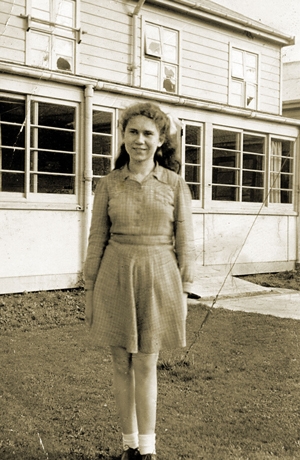
At last her plaster came off—briefly. Her rudimentary English did not stretch to understanding apparent instructions not to stand up. She followed her natural instincts and stood, broke her knee and had to go into plaster again. Stasia was grateful that this time she was allowed to recover in the hospital’s Silverstream facility, where she is pictured here.
As Stasia absorbed the English language and the informal teaching she was being given in English, back in Pahiatua teachers prepared the children for return to Poland with Polish grammar, literature, geography and history.
Stasia enjoyed occasional weekends away with her new teacher, Mrs Johnson, visiting her mother in Upper Hutt before she married and, later, to her new home in Napier. Stasia sent her brothers the photograph below, taken by Mrs Johnson of her husband with Stasia.
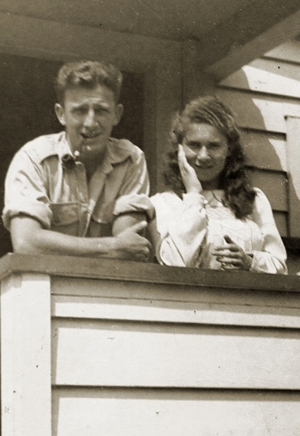
Despite the attention her limp received, it was still with her when she left the Silverstream recuperation unit and her knee never did completely heal.
By the time Stasia returned to Pahiatua and schooled formally, the camp lessons were also in English. After World War 2, few of the Poles in New Zealand had a reason to return to a Poland under a Soviet-imposed communist-controlled government. The New Zealand government allowed those Poles who wanted to remain in New Zealand to do so. Most did—Poland was not the same country from which they had been forcibly exiled, and in any case, their land had been absorbed by the USSR.
When the children’s camp closed in 1949, Stasia went to live at a new hostel established for Polish girls at Lyall Bay, Wellington, and finished Standard Six in nearby Kilbirnie. She has fond memories of the nuns who ran the hostel, especially Sister Alexandra (Alexandrowicz), but not of the bullies who waited outside the hostel gates and yelled at the girls walking to school to—among other things—“Go back to Poland.”
“It’s not that they called us names. We didn’t care, and we shouted back, but they used to grab our lunch and smash it. You only get breakfast and four little sandwiches [for school]… and tea (a light meal). You don’t get supper and you get hungry.
A year later Stasia made another move, this time as a high school boarder at the Sacred Heart Convent in New Plymouth. Many of the pupils were daughters of farmers in the area. Again she was the lone Polish girl and she felt that loneliness especially when parents visited their daughters on Sundays bringing them gifts and treats to eat.
“The nuns said to me ‘Stasia, you’ve been an orphan for so long, why don’t you go and see the world?…’”
Stasia had learnt not to talk of her background. Who would believe her? She became friends with another ‘unpopular’ girl who gave her her first banana. “I started to eat it with the skin on. How was I to know?”
The sheltered convent life convinced Stasia that she wanted to become a nun and work helping children in need. She believed she had the required experience.
“The nuns said to me ‘Stasia, you’ve been an orphan for so long, why don’t you go and see the world? If you don’t like it, you can always come to the convent.’
“And when I left the convent, I discovered I liked the world, I loved the clothes… I went back to see the nuns and they asked if I was coming back but I said no.’
_______________
Stasia was at last able to live with Władek at the Wellington house he shared with his wife—also named Stasia—in George Street, Thorndon. Stasia appreciated the dresses and skirts her namesake sewed for her. It was a large, four-bedroomed place shared also with Władek’s wife Stasia’s older sister, Janina, her husband, Mikołaj Nowatorski, and daughter, Tereska.
They all moved to Sydney Street in Petone, Lower Hutt. Stasia worked at the cigarette factory nearby and settled into life in New Zealand. She met her Irish husband, George Kennedy, at a Petone Rowing Club dance.
“He took me home, I said goodbye, forgot about it, and a couple of weeks later he comes knocking at the door. He says, ‘Do you remember me, Stasia?’ I said, ‘No.’ He says, ‘I met you at the dance. I know it was you because you were dressed so beautifully and I remembered your hair.’”
“After we got engaged, he told me he had something to tell me… he had jumped ship in Wellington the year before.” The eldest of seven children, George became a sailor after his father died. When his ship docked in Wellington, he knew he had found the place he wanted to stay. Stasia asked Władek for advice and was reassured. Władek described George as “a nice, friendly chap” worthy of marrying.
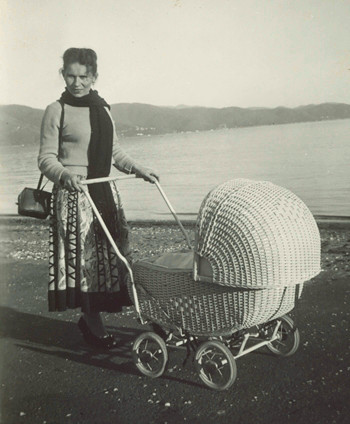
George moved into the Sydney Street house but once their first daughter, Marysia, was born the room became too small and he took on three jobs to save for a place of their own.
Left is Stasia taking Marysia for a walk along the Esplanade in Petone, which runs perpendicular to Sydney Street. Behind her is the Wainuiomata hill where George found a section (land) they could afford.
Unlike today, the road to the new sub-division was “terrible”—winding and steep. The Kennedys qualified for a state mortgage to build a two-bedroomed house. They moved in a month before their second daughter, Kathleen, was born in November 1959.
George told Stasia she could name their first child as long as he was allowed to name the next. He also named their son, Sean Patrick (“You don’t get more Irish than that.”) and third daughter, Eileen.
Below, Stasia with the children at Wainuiomata beach around 1961. Sean is in Kathleen's shadow, Marysia is in the middle and Eileen next to their mother.
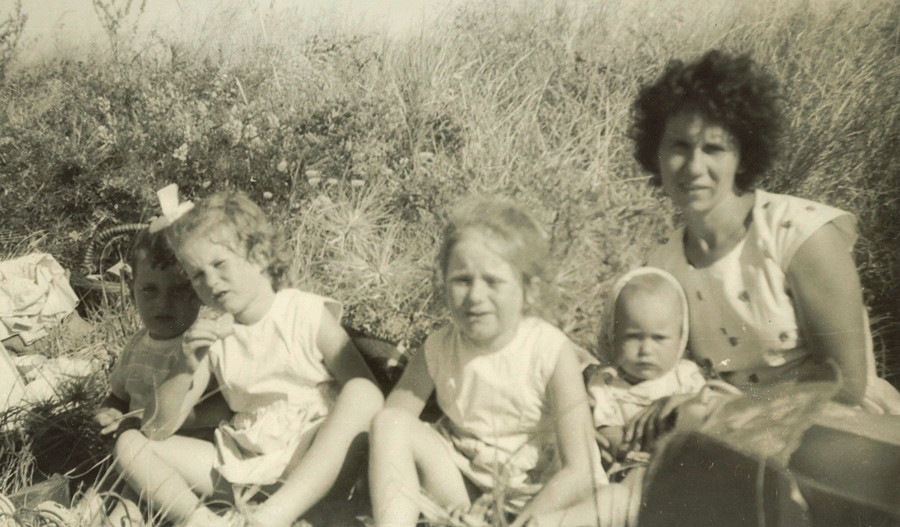
“We had only one neighbour over the road and no shops. They had to deliver the milk and we had no curtains, no fridge, no washing machine and I had to walk to the village and order my groceries because we had no phone. On Saturdays a van used to come around and sell vegetables.”
In winter, walks to the shops became bus rides. There were few other luxuries as the young couple built up their home comforts one appliance at a time—a fridge first and, after Sean’s birth, a washing machine. Stasia kept a productive garden and her husband, who worked on the wharves with Bronek, built on more rooms.
George died suddenly of a heart attack two years after his retirement at 60.
Stasia’s experiences as a child reflected in the way she brought up her own children.
“I wanted to give them what I never had. I made sure I cooked enough so they never went hungry. I never threw any food away because I knew some people were starving. I can’t throw away food. People in New Zealand don’t know what hunger means.”
She is still wary of talking about her experiences. Several years ago a documentary on the Polish children who settled in Pahiatua aired on New Zealand television. The next Sunday Stasia was having tea after Mass when people at her table started talking about it. The consensus seemed to be one of scepticism with one woman saying, “I can’t believe it… this can’t be true, nobody can be that cruel.”
The woman sitting next to Stasia asked her what year she had come to New Zealand.
“I said 1944, first of November. I said I was one of [the Pahiatua children] and she said, ‘But you never talk about it.’ And I don’t. I don’t talk about it because people don’t believe me. They say, ‘You’re making it up, Stasia.’
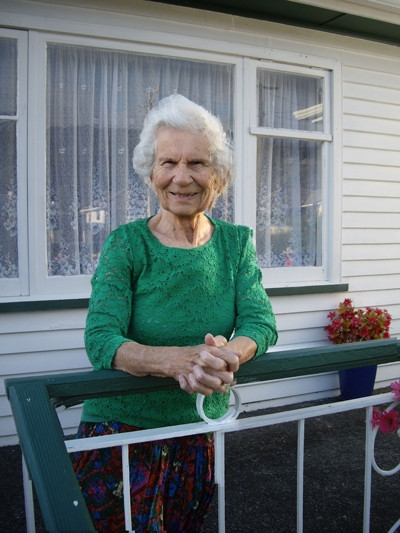
“Why would I make it up, something like that?
“Sometimes I lie in bed and think about it, all the things that I went through and how I survived. I can’t believe it myself but still, I survived. I was meant to survive. I don’t talk about it, except to my brother, only to ask him a few questions. He said, ‘What you remember, Stasia, everything’s true.’
“It’s not their fault I went through the war. What do I have to be nasty for? Why do I have to talk about it? I tell myself, ‘Just forget about it.’
“But I don’t forget. I don’t forget. To the day I die, I won’t forget.”
© Barbara Scrivens, 2015
Updated October 2016
APART FROM THE SHIP AND THE LAST, ALL PHOTOGRAPHS ARE FROM THE KENNEDY COLLECTION.
THANKS TO THE NORTH AUCKLAND RESEARCH CENTRE IN THE TAKAPUNA LIBRARY FOR THE LOAN OF AUDIO RECORDING EQUIPMENT.
ENDNOTES:
- 1 - See the chapter Kolyma Means Death in General Władysław Anders' book An Army in Exile originally published in 1949. Reprinted by The Battery Press, Nashville, ISBN: 0-89839-043-5.
- 2 - “Deportation” is one of the Soviet descriptions of the Poles' forced removal. Another is “free exile”.
- 3 - Image from: http://www.rymaszewski.iinet.net.au/index.html
- 4 - The Polish Institute and Sikorski Museum is a London-based non-governmental organisation of the Polish community in the UK. Address: 20 Prince's Gate, London, SW7 1PT. Opening hours found on: http://www.pism.co.uk/
